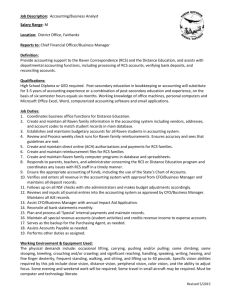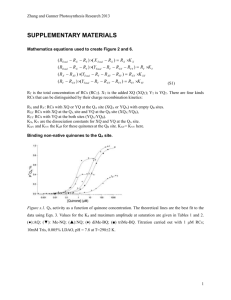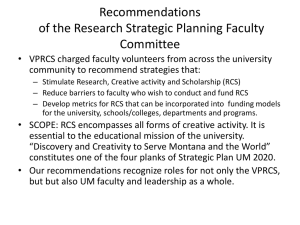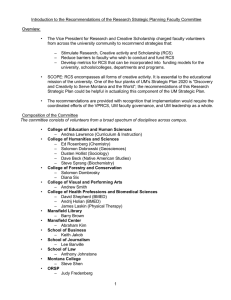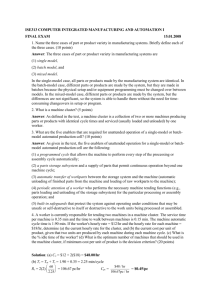Integrating Disparate Knowledge Representations Within 4D/RCS
advertisement
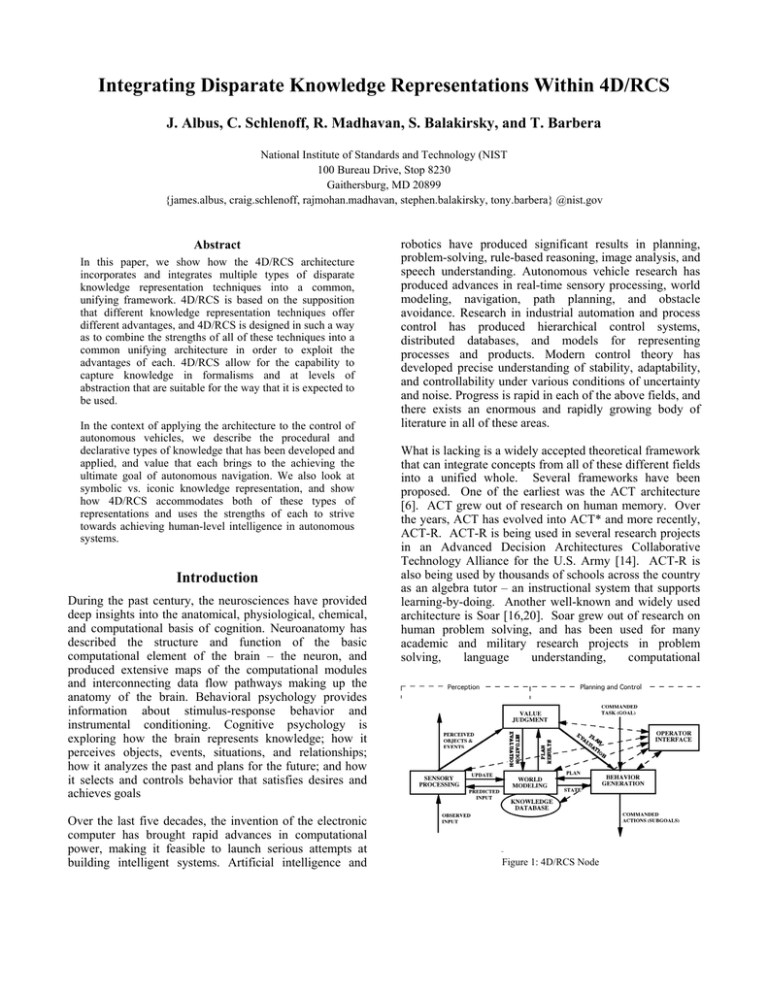
Integrating Disparate Knowledge Representations Within 4D/RCS
J. Albus, C. Schlenoff, R. Madhavan, S. Balakirsky, and T. Barbera
National Institute of Standards and Technology (NIST
100 Bureau Drive, Stop 8230
Gaithersburg, MD 20899
{james.albus, craig.schlenoff, rajmohan.madhavan, stephen.balakirsky, tony.barbera} @nist.gov
Abstract
In this paper, we show how the 4D/RCS architecture
incorporates and integrates multiple types of disparate
knowledge representation techniques into a common,
unifying framework. 4D/RCS is based on the supposition
that different knowledge representation techniques offer
different advantages, and 4D/RCS is designed in such a way
as to combine the strengths of all of these techniques into a
common unifying architecture in order to exploit the
advantages of each. 4D/RCS allow for the capability to
capture knowledge in formalisms and at levels of
abstraction that are suitable for the way that it is expected to
be used.
In the context of applying the architecture to the control of
autonomous vehicles, we describe the procedural and
declarative types of knowledge that has been developed and
applied, and value that each brings to the achieving the
ultimate goal of autonomous navigation. We also look at
symbolic vs. iconic knowledge representation, and show
how 4D/RCS accommodates both of these types of
representations and uses the strengths of each to strive
towards achieving human-level intelligence in autonomous
systems.
Introduction
During the past century, the neurosciences have provided
deep insights into the anatomical, physiological, chemical,
and computational basis of cognition. Neuroanatomy has
described the structure and function of the basic
computational element of the brain – the neuron, and
produced extensive maps of the computational modules
and interconnecting data flow pathways making up the
anatomy of the brain. Behavioral psychology provides
information about stimulus-response behavior and
instrumental conditioning. Cognitive psychology is
exploring how the brain represents knowledge; how it
perceives objects, events, situations, and relationships;
how it analyzes the past and plans for the future; and how
it selects and controls behavior that satisfies desires and
achieves goals
Over the last five decades, the invention of the electronic
computer has brought rapid advances in computational
power, making it feasible to launch serious attempts at
building intelligent systems. Artificial intelligence and
robotics have produced significant results in planning,
problem-solving, rule-based reasoning, image analysis, and
speech understanding. Autonomous vehicle research has
produced advances in real-time sensory processing, world
modeling, navigation, path planning, and obstacle
avoidance. Research in industrial automation and process
control has produced hierarchical control systems,
distributed databases, and models for representing
processes and products. Modern control theory has
developed precise understanding of stability, adaptability,
and controllability under various conditions of uncertainty
and noise. Progress is rapid in each of the above fields, and
there exists an enormous and rapidly growing body of
literature in all of these areas.
What is lacking is a widely accepted theoretical framework
that can integrate concepts from all of these different fields
into a unified whole. Several frameworks have been
proposed. One of the earliest was the ACT architecture
[6]. ACT grew out of research on human memory. Over
the years, ACT has evolved into ACT* and more recently,
ACT-R. ACT-R is being used in several research projects
in an Advanced Decision Architectures Collaborative
Technology Alliance for the U.S. Army [14]. ACT-R is
also being used by thousands of schools across the country
as an algebra tutor – an instructional system that supports
learning-by-doing. Another well-known and widely used
architecture is Soar [16,20]. Soar grew out of research on
human problem solving, and has been used for many
academic and military research projects in problem
solving,
language
understanding,
computational
Figure 1. RCS Node
Figure 1: 4D/RCS Node
linguistics, theorem proving, and cognitive modeling.
Other cognitive architectures include Prodigy, ICARUS,
IMPRINT, EPIC, and 4D/RCS. Like Soar, Prodigy uses
search through a problem space to achieve goals cast as
first-order expressions [19]. ICARUS is a reactive
architecture that encodes knowledge as reactive skills [24].
IMPRINT is a task description language designed for the
Army to capture the procedural specification of tactical
behavior scenarios [8]. It contains a dynamic, stochastic,
discrete-event network modelling tool designed to help
assess the interaction of soldier and system performance
throughout the system lifecycle – from concept and design
through field testing and system upgrades. IMPRINT has
been integrated with ACT-R to model military behaviors
[7]. EPIC is an architecture that models the detailed timing
of human perceptual, cognitive, and motor activity,
including the input/output characteristics of the nervous
system connecting the higher level cognitive functions to
the external world [15]. 4D/RCS is a control system
architecture inspired by a theory of cerebellar function [1].
4D/RCS models the brain as a hierarchy of goal-directed
sensory-interactive intelligent control processes that
theoretically could be implemented by neural nets, finite
state automata, cost-guided search, or production rules [5].
4D/RCS is similar to other cognitive architectures in that it
represents procedural knowledge in terms of production
rules, and represents declarative knowledge in abstract data
structures such as frames, classes, and semantic nets.
4D/RCS differs from other cognitive architectures in that it
also includes signals, images, and maps in its knowledge
database, and maintains a tight real-time coupling between
iconic and symbolic data structures in its world model.
4D/RCS is also different in: a) its focus on task
decomposition as the fundamental organizing principle; b)
its level of specificity in the assignment of duties and
responsibilities to agents and units in the behavior
generating hierarchy; and c) its emphasis on controlling
real machines in real-world environments.
Background of 4D/RCS
4D/RCS evolved from the bottom up as a real-time
intelligent control system for real machines operating on
real objects in the real world. The first version of RCS
was developed as a sensory-interactive goal-directed
controller for a laboratory robot [10]. The fundamental
element is the control loop with a goal, a transition
function, a feedback loop, and an action output such as a
force, velocity, or position. Over the years, RCS has
evolved into an intelligent controller for industrial robots,
machine tools, intelligent manufacturing systems,
automated general mail facilities, automated stamp
distribution systems, automated mining equipment,
unmanned underwater vehicles, and unmanned ground
vehicles [2,11].
The most recent version of RCS
(4D/RCS) embeds elements of Dickmanns [13] 4-D
approach to machine vision within the 4D/RCS control
architecture. 4D/RCS was designed for the U.S. Army
Research Lab AUTONAV and Demo III Experimental
Unmanned Vehicle programs and has been adopted by the
Army Future Combat System program for Autonomous
Navigation Systems [3,4].
4D/RCS consists of a multi-layered multi-resolutional
hierarchy of computational nodes each containing elements
of sensory processing (SP), world modeling (WM), value
judgment (VJ), behavior generation (BG), and a
knowledge database (KD), as shown in Figure 1.
Throughout the hierarchy, interaction between SP, WM,
VJ, BG, and KD give rise to perception, cognition, and
reasoning. At low levels, representations of space and
time are short-range and high-resolution. At high levels,
distance and time are long-range and low-resolution. This
enables high-precision fast-action response at low levels,
while long-range plans and abstract concepts are being
simultaneously formulated at high levels. The hierarchical
approach also helps to manage computational complexity.
4D/RCS closes feedback loops at every level, through
every node. SP processes focus attention (i.e., window
regions of space or time), group (i.e., segment regions into
entities), compute entity attributes, estimate entity state,
and assign entities to classes at every level. WM processes
maintain a rich and dynamic database of knowledge about
the world in the form of images, maps, entities, events, and
relationships at every level. Other WM processes use that
knowledge to generate estimates and predictions that
support perception, reasoning, and planning at every level.
VJ processes assign worth and importance to objects and
events, compute confidence levels for variables in the
knowledge database, and evaluate the anticipated results of
hypothesized plans.
Enabling Intelligence in Autonomous Vehicles
The Many Dimensions of Knowledge in 4D/RCS
The 4D/RCS architecture is designed in such a way as to
accommodate multiple types of representation formalisms
and provide an elegant way to integrate these formalisms
into a common, unifying framework. This section will
describe the types of knowledge representations that have
been researched and/or implemented within the 4D/RCS
architecture for autonomous driving and the mechanisms
that have been deployed to integrate them.
As mentioned previously, 4D/RCS is a hierarchical
architecture, and as such, supports knowledge
representation at different levels of abstraction.
Traditionally, the lowest levels of the architecture
primarily contain state variables such as actuator positions,
velocities, and forces, pressure sensor readings, position of
switches, gearshift settings, and inertial sensors for
detecting gravitational and locomotion acceleration and
rotary motion. The next higher level of the hierarchy (and
above) contains map-based information, with decreasing
resolution and increasing spatial extent as one proceeds
higher up the hierarchy. The further up the hierarchy, a
combination of map-based representations and object
knowledge bases are used, which contain names and
attributes of environmental features such as road edges,
holes, obstacles, ditches, and targets. These maps represent
the shape and location of terrain features and obstacle
boundaries. Still higher up the hierarchy is symbolic
information referring to the location of vehicles, targets,
landmarks, and local terrain features such as buildings,
roads, woods, fields, streams, fences, ponds, etc. The top
levels of the hierarchy primarily deal with groups of
objects, such as groups of people, buildings, or vehicles.
These groups are treated as a single entity, with average
characteristics (e.g., speed, location, color) used to
describe them.
This knowledge is stored within the Knowledge Database
(KD). The KD consists of data structures that contain the
static and dynamic information that collectively form a
model of the world. The KD contains the information
needed by the world model to support the behavior
generation, sensory processing, and value judgment
processes within each node. Knowledge in the KD
includes the system’s best estimate of the current state of
the world plus parameters that define how the world state
can be expected to evolve in the future under a variety of
circumstances.
Figure 2 shows the many different types of knowledge
representation formalisms that are currently being
implemented within the 4D/RCS architecture as applied to
autonomous driving. These formalisms range from iconic
to symbolic and from procedural to declarative.
Knowledge is captured in formalisms and at levels of
abstraction that are suitable for the way that it is expected
to be used. Different knowledge representation techniques
offer different advantages, and 4D/RCS is designed in such
a way as to combine the strengths of all of these techniques
into a common unifying architecture in order to exploit the
advantages of each. In the following subsections, we will
describe some of the formalisms depicted, classifying
knowledge as either procedural or declarative.
Procedural Knowledge
Procedural knowledge is the knowledge of how to perform
tasks. Procedural knowledge is different from other kinds
of knowledge, such as declarative knowledge, in that it can
be directly applied to a task. Within 4D/RCS, procedural
knowledge is primarily used for planning and control
purposes. As such, we will describe two planning
approaches that are currently being implemented in
4D/RCS and describe the knowledge that underlies each.
Both planning approaches start with the same 4D/RCS
methodology for determining the knowledge which needs
to be represented to accomplish the planning task. The
methodology starts as follows:
1.
The first step involves an intensive analysis of
domain knowledge from manuals and subject
CONDUCT TACTICAL ROAD MARCH TO ASSEMBLY AREA
1
2
S1
3
S2
Cost-based Models
State
Machine
Planning
Perception
Co
Pla st B
nn ase
i ng d
Si
Ontology
io n
lat
mu
Use Cases
M
Ob ovin
Pr ject g
ed
ict
ion
Autonomous Vehicle Ontologies
all_FormTacticalRoadMarchOrganization
S3
DetermineMarchColumnOrganization:
MakeTentativePlan: Determine_Route,
_FireSupport, _MovementFactors, _AA
sp3_PrepareForRouteReconnaissance
qp_PrepareToOrganizeAssemblyArea
S4
5
S4
sp3_ReadyToConductRouteRecon
S5
6
S5
qp_ReadyToOrganizeAA
S6
7
S6
qp_ClearOfStartPoint
S7
mb_tp_PrepareForRoadMarch
8
S7
mb_tp_ReconToStartPoint_Done
S8
PrepareDetailedMovementPlans:
9
S8
sp3_RouteRecon_Done
S9
sp3_EstablishAssemblyAreaSecurity
10
S9
qp_AtReleasePoint
S10
qp_ConductAreaReconnaissanceOfAA
11
S10
qp_AreaReconOfAADone
S11
12
S11
qp_Status_AssemblyAreaSuitable
S12
1st_mb_Unit_MoveIntoRoadMarchFormation
13
S12
mb_Unit_AtStartPoint
S12
14
S12
mb_LastUnit_AtStartPoint
mb_Unit_ExecuteTacticalRoadMarch
next_mb_unit_MoveIntoRoadMarchFormation
mb_Unit_ExecuteTacticalRoadMarch
tp_MoveIntoRoadMarchFormation
S13
sp3_ConductRouteReconnaissance
qp_FollowReconPlatoonToAssemblyArea
qp_OrganizeAssemblyArea
15
S13
tp_TrailPartyAtStartPoint
S14
16
S14
HaltCriteriaMet
S15
mb_tp_ExecuteScheduledHalt
17
S15
HaltEnded_ReadyToContinueMarch
S14
mb_tp_ResumeExecutionOfTacticalRoadMarch
tp_SupportMarchColumnMovement
DisabledVehicleUnscheduledHalt
S15
mb_tp_ExecuteUnscheduledHalt
S14
mb_Unit_AtReleasePoint
qp_AssemblyAreaReady
S16
1st_mb_Unit_OccupyAssemblyArea
20
S16
mb_Unit_AtReleasePoint
S16
mb_Unit_OccupyAssemblyArea
21
S16
tp_AtReleasePoint
S17
tp_OccupyAssemblyArea
22
S17
mb_tp_OccupyingAssemblyArea
S18
23
S18
AllUnitsSecureInAssemblyArea
S0
19
Prediction Equations
S2
TentativePlans_Done
RoadMarchOrganizationInPlace
18
lue
Va ent
m
dg
Ju
S1
MarchOrganizationDetermined
S3
4
Layered Terrain Maps
NewCommand
24
NewSituationReport
25
NewHigherLevelInformation
all_FormStandardTroopOrganization
TacticalRoadMarchToAssemblyArea_Done
UpdateDetailedMovementPlans
UpdateDetailedMovementPlans
State Tables
LADA R and Color Camera Images
Ground Truth
Databases
Figure 2: Knowledge Representations in 4D/RCS
2.
matter experts, especially using scenarios of
particular subtask operations. The output of the
effort is a structuring of this knowledge into a
task decision tree consisting of simpler and
simpler commands (actions/verbs) at simpler and
simpler levels of task description.
The second step defines the hierarchical
organization of agent control modules that will
execute these layers of commands in such a
manner as to reasonably accomplish the tasks.
This is the same as coming up with a business or
military organizational structure of agent control
modules (people, soldiers) to accomplish the
desired tasks. This step forces a more formal
structuring of all of the subtask activities and
responsibilities, as well as defining the execution
structure.
At this point, the two approaches diverge in the procedure
for determining the types of knowledge necessary to
accomplish the planning task. Subsequent steps are
described in the following subsections.
State Machine-Based Planning (a)
The state machine-based methodology concentrates on the
task decomposition as the primary means of understanding
the knowledge required for intelligent control. Once the
previous two steps are performed, the procedure proceeds
as follows:
3a. The third step clarifies the processing of each
agent's input command through the use of rules to
identify all of the task branching conditions with
their corresponding output commands. Each of
these command decompositions at each agent
control module will be represented in the form of
a state-table of ordered production rules (which is
an implementation of an extended finite state
machine (FSM)). The sequence of simpler output
commands required to accomplish the input
command and the named situations (branching
conditions) that transition the state-table to the
next output command are the primary knowledge
represented in this step.
4a. In the fourth step, the above named situations that
are the task branching conditions are defined in
great detail in terms of their dependencies on
world and task states. This step attempts to define
the detailed precursor states of the world that
cause a particular situation to be true.
5a. In the fifth step, we identify and name all of the
objects and entities together with their particular
features and attributes that are relevant to defining
the above world states and situations. Current
efforts are exploring the use of ontologies and
databases to represent this information.
6a. The sixth step uses the context of the particular
task activities to establish the distances and,
therefore, the resolutions at which the above
objects and entities must be measured and
recognized by the sensory processing component.
This step establishes a set of requirements and/or
specifications for the sensor system at the level of
each separate subtask activity.
As described in the previous four steps, this approach
relies on various knowledge representation formalisms,
such as state tables, production rules, situation
representation, ontologies, databases, and sensor images.
Cost-Based Planning Representations (b)
The cost based methodology concentrates on decomposing
each of its assigned tasks into an optimal sequence of
commands that will be assigned to its subordinates. This is
accomplished through the incremental creation and
evaluation of a planning graph [9]. Once again, the first
two steps from section 3.2 must be performed and are then
followed by:
3b. The third step develops an action model that
delineates how each of the subordinate’s
commands will affect the system state at the
current level of resolution. This allows a
simulation system to experiment with various
command options in order to obtain the state
transitions that are required to fulfill the level’s
goals.
4b. The fourth step develops a set of user constraints
and objectives that could affect the cost/benefit
ratio of performing a given action or occupying a
given state. For example, the cost/benefit of
running a red light would be substantially
different for a casual driver than it would be for a
person driving their wife to the hospital to deliver
a baby.
5b. Step 5 examines the potential state variable
transitions that have been identified along with
the potential user constraints and objective in
order to construct a cost function that will be
utilized by the value judgment module during the
graph expansion process.
By developing the state transition simulator from step 3 we
are able to incrementally build a planning graph based on
potential actions that a subordinate may take. The cost
function developed in step 5 may then be used to evaluate
the individual arcs of the planning graph in order to control
the expansion order and find the cost optimal path through
the planning graph.
Similar to the state-based planning approach, this approach
relies on various knowledge representation formalisms,
such as state tables, cost-based models, situation
representation, ontologies, databases, and sensor images.
Declarative Knowledge
Declarative knowledge is represented in a format that may
be manipulated, decomposed, and analyzed by reasoners.
Unlike procedural knowledge, it does not describe how to
perform a given task. Instead, it provides the ability to use
knowledge in ways that the system designer did not
foresee. Two classes of declarative knowledge that is
captured within 4D/RCS are symbolic knowledge and
iconic knowledge. In the follow two subsections, we
describe details about these two types of knowledge
representations.
Symbolic Knowledge
Symbolic representations use symbols to represent events
or objects in the world. Two types of symbolic
representations that are being implemented within 4D/RCS
are ontologies and relational databases.
Ontologies represent key concepts, their properties, their
relationships, and their rules and constraints within a given
domain. Ontologies often focus more on the meaning of
concepts than on the terms that are used to represent them.
Two efforts have focused on the development of
ontologies for autonomous navigation.
The first is an ontology for roadway driving, which is used
to determine if objects in the environment are potential
obstacles to our vehicle. The system is composed of an
ontology of objects representing “things” that may be
encountered in our current environment, in conjunction
with rules for estimating the damage that would be
incurred by collisions with the different objects in different
situations. Automated reasoning is used to estimate
collision damage, and this information is fed to the route
planner to help it decide whether to avoid the object. More
information about this effort can be found at [21].
The second is an ontology to model tactical behaviors,
which is based upon the OWL-S specification (Web
Ontology Language- Services) [25]. In this context,
behaviors are actions that an autonomous vehicle is
expected to perform when confronted with a predefined
situation. The ontology is stored within the 4D/RCS
knowledge database, and the behaviors will be spawned
when situations in the world are determined to be true, as
judged by sensor information and the value judgment
components. More information about this effort can be
found in [23].
In addition to ontologies, databases have been developed
to house symbolic information. The database that has
received the most attention to date is the Road Network
Database. [22] The database includes detailed information
about the roadway, such as where the road lies, rules
dictating the traversal of intersections, lane markings, road
barriers, road surface characteristics, etc. The purpose of
the Road Network Database is to provide the data
structures necessary to capture all of the information
necessary about road networks so that a planner or control
system on an autonomous vehicle can plan routes along the
roadway at any level of abstraction. At one extreme, the
database provides structures to represent information so
that a low-level planner can develop detailed trajectories to
navigate a vehicle over the span of a few meters. At the
other extreme, the database provides structures to represent
information so that a high-level planner can plan a course
across a country. Each level of planning requires data at
different levels of abstraction, and as such, the Road
Network Database must accommodate these requirements.
Iconic Knowledge
Iconic knowledge is often spatial in nature and can be
defined as 2D or 3D array data in which the dimensions of
the array correspond to dimensions in physical space. The
value of each element of the array may be Boolean data,
real number, or vector data representing a physical
property such as light intensity, color, altitude, range, or
density. Each element may also contain spatial or temporal
gradients of intensity, color, range, or rate of motion. Each
element may also contain a pointer to a geometric entity
(such as an edge, vertex, surface, or object) to which the
pixel belongs.
Examples of iconic knowledge used within 4D/RCS
include digital terrain maps, sensor images, models of the
kinematics of the machines being controlled, and
knowledge of the spatial geometry of parts or other objects
that are sensed and with which the machine interacts in
some way. This is where objects and their relationship in
space and time are modeled in such a way as to represent
and preserve those spatial and temporal relationships, as in
a map, image, or trajectory.
Within 4D/RCS, maps enhance the scope of the world
model. Such iconic maps may take a variety of forms
including survey and aerial maps and may provide
significant information about existing topology and
structures. The higher levels in the 4D/RCS control
hierarchy includes feature and elevation data from a priori
digital terrain maps such as information about roads,
bridges, streams, woods, and buildings. This information
needs to be registered and merged with data from the lower
level maps that are generated by sensors. Additionally, for
incorporating a priori knowledge into the world model,
some form of weighting is required and this depends on
how well the a priori data and the sensed information are
registered. There is also the need to generate higher
resolution a priori terrain maps as the current survey maps
are too coarse for autonomous driving. Another potential
application for registering sensor data is the computation
of ground truth.
Towards registering LADAR range images to a priori
maps, we have developed an iterative algorithm that can
deal with false/spurious matches, occlusions and outliers
for UGV navigation [18]. The iterative registration
algorithm can be summarized as follows: Given an initial
motion transformation between two 3D point sets, a set of
correspondences are developed between data points in one
set and the next. For each point in the first data set, we find
the point in the second that is closest to it under the current
transformation. It should be noted that correspondence
between the two points sets is initially unknown and that
point correspondences provided by sets of closest points is
a reasonable approximation to the true point
correspondence. From the set of correspondences, an
incremental motion can be computed facilitating further
alignment of the data points in one set to the other. This
correspondence/compute motion process is iterated until a
predetermined threshold termination condition.
A hybrid iterative algorithm has also been developed for
registering 3D LADAR range images obtained from
unmanned aerial and ground vehicles [17]. Combined with
a feature-based approach, the algorithm was shown to
produce accurate registration for the two sets of LADAR
data. Registration of the UGV LADAR to the aerial survey
map minimizes the dependency on GPS for position
estimation especially when the GPS estimates are
unreliable or unavailable.
Results
Experimental validation of the 4D/RCS architecture and
the knowledge representation within has been provided by
the performance of the Demo III eXperimental Unmanned
ground Vehicles (XUVs) in an extended series of
demonstrations and field tests during the winter of 20022003.
The XUVs were equipped with an inertial reference
system, a commercial grade GPS receiver (accurate to
about +/- 20 m), a LADAR camera with a frame rate of 10
frames per second, and a variety of internal sensors. The
LADAR had a field of view 90 degrees wide and 20
degrees high with resolution of about ½ degree per pixel.
It was mounted on a pan/tilt head that enabled it to look in
the direction that the vehicle planned to drive. The
LADAR detected the ground out to a range of about 20 m,
and detected vertical surfaces (such as trees) out to a range
of about 60 m. Routes for XUV missions were laid out on
a terrain map by trained Army scouts, and given to the
XUVs in terms of GPS waypoints spaced over 50 m apart.
The XUVs operated completely autonomously until they
got into trouble and called for help. Typical reasons for
calling for help were the XUV was unable to proceed
because of some terrain condition or obstacle (such as soft
sand on a steep slope, or dense woods), and was unable to
find an acceptable path plan after several attempts at
backing up and heading a different direction. At such a
point, an operator was called in to teleoperate the vehicle
out of difficulty. During these operations, data was
collected on the cause of the difficulty, the type of operator
intervention required to extract the XUV, the time required
before the XUV could be returned to autonomous mode,
and the work load on the operator.
During three major experiments designed to determine the
technology readiness of autonomous driving, the Demo III
experimental unmanned vehicles were driven a total of 550
km, over rough terrain: 1) in the desert; 2) in the woods,
through rolling fields of weeds and tall grass, and on dirt
roads and trails; and 3) through an urban environment with
narrow streets cluttered with parked cars, dumpsters,
culverts, telephone poles, and manikins. Tests were
conducted under various conditions including night, day,
clear weather, rain, and falling snow. The unmanned
vehicles operated over 90% of both time and distance
without any operator assistance. An extensive report of
these experiments has been published [12], along with high
resolution ground truth data describing the terrain where
the XUVs experienced difficulties [26].
It should be noted that the Demo III tests were performed
in environments devoid of moving objects such as oncoming traffic, pedestrians, or other vehicles.
The
inclusion of moving objects in the world model, and the
development of perception, world modeling, and planning
algorithms for operating in the presence of moving objects
is a topic of current research.
Conclusion
We believe that the 4D/RCS architecture provides an
excellent framework in which to integrate multiple
knowledge representation approaches to build cognitive
models and intelligent systems that significantly advance
the level of intelligence we can achieve. In this paper, we
have described how 4D/RCS supports multiple types of
representations, ranging from iconic to symbolic and from
declarative to procedural, and provided brief examples of
how each of these representations are used in the context
of autonomous driving. We also show how all of these
knowledge representation formalisms not only fit into the
node structure present at each level of the 4D/RCS
hierarchy, but also play in the role in the 4D/RCS
methodologies described in Section 3.2.
We also believe that autonomous driving is an excellent
topic for continued research on intelligent systems for the
following reasons:
• It is a problem domain for which there is a large
potential user base, both in the military and civilian
sectors. This translates into research funding.
• It is a problem domain where physical actuators and
power systems are readily available. Wheeled and
tracked vehicle technology is mature, inexpensive, and
widely deployed.
• It is a problem domain for which the technology is
ready. The invention of real-time LADAR imaging
makes it possible to capture the 3-D geometry and
dynamics of the world. This has broken the perception
barrier. The continued exponential growth rate in
computing power per dollar cost has brought the
necessary computational power within the realm of
economic viability. This has broken the cost barrier.
Intelligent control theory has advanced to the point
where the engineering of intelligent systems is feasible.
This has broken the technology barrier.
• It is problem domain of fundamental scientific interest.
Locomotion is perhaps the most basic of all behaviors in
the biological world. Locomotion is essential to finding
food and evading predators throughout the animal
kingdom. The brains of all animate creatures have
evolved under the pressures of natural selection in
rewarding successful locomotion behavior.
It is
therefore, not unreasonable to suspect that building truly
intelligent mobility systems will reveal fundamental new
insights into the mysteries of how the mechanisms of
brain give rise to the phenomena of intelligence,
consciousness, and mind.
References
1. Albus, J., "A Theory of Cerebellar Function,"
Mathematical Biosciences, Vol. 10, 1971, pp. 2561.
2. Albus, J., "The NIST Real-time Control System
(RCS): An approach to Intelligent Systems
Research," Journal of Experimental and Theoretical
Artificial Intelligence, Vol. 9, 1997, pp. 157-174.
3. Albus, J. and et.al., "4D/RCS Version 2.0: A
Reference Model Architecture for Unmanned
Vehicle Systems," NISTIR 6910, National Institute
of Standards and Technology, Gaithersburg, MD,
2002.
4. Albus, J. and Meystel, A., Engineering of Mind,
John Wiley & Sons, Inc. 2001.
5. Albus, J. S., Brain, Behavior, and Robotics,
McGraw-Hill 1981.
6. Anderson, J., The Architecture of Cognition,
Lawrence Erlbaum Associates, Mahwah, N.J., 1983.
7. Archer, R., Lebriere, C., Warwick, W., and Schunk,
D., "Integration of Task Network and Cognition
Models to Support System Design," Proceedings of
the Collaborative Technology Alliances
Conference: 2003 Advanced Decision Architectures,
College Park, MD, 2003.
8. Archer, S. and Adkins, R., "IMPRINT User's
Guide," 1999.
9. Balakirsky, S., A Framework for Planning with
Incrementally Created Graphs in Attributed
Problem Spaces, IOS Press, Berlin, Germany, 2003.
10. Barbera, T., Albus, J., and Fitzgerald, M.,
"Hierarchical Control of Robots Using
Microcomputers," Proceedings of the 9th
International Symposium on Industrial Robots,
Washington DC, 1979.
11. Barbera, T., Fitzgerald, M., Albus, J., and Haynes,
L. S., "RCS: The NBS Real-Time Control System,"
Proceedings of the Robots Conference and
Exposition, Detroit, Michigan, 1984.
12. Camden, R., Bodt, B., Schipani, S., Bornstein, J.,
Phelps, R., Runyon, T., French, F., and Shoemaker,
C., "Autonomous Mobility Technology Assessment
Interim Report," Army Research Laboratory (ARLMR-565), 2003.
13. Dickmanns, E. D., "An Expectation-Based MultiFocal Saccadic (EMS) Vision System for Vehicle
Guidance," Proceedings of the 9th International
Symposium on Robotics Research (ISRR'99), Salt
Lake City, 1999.
14. Gonzalez, C., "ACT-R Implementation of an
Instance-Based Decision Making Theory,"
Proceedings of the Collaborative Technology
Alliance Conference: 2003 Advanced Decision
Architectures, College Park, MD, 2003.
15. Kieras, D. and Meyer, D. E., "An overview of the
EPIC architecture for cognition and performance
with application to human-computer interaction,"
Human-Computer Interaction, Vol. 12, 1997, pp.
391-438.
16. Laird, J. E., Newell, A., and Rosenbloom, P. S.,
"SOAR: An Architecture for General Intelligence,"
Artificial Intelligence, Vol. 33, 1987, pp. 1-64.
17. Madhavan, R., Hong, T., and Messina, E.,
"Temporal Range Registration for Unmanned
Ground and Aerial Vehicles," Proceedings of the
IEEE International Conference on Robotics and
Automation (ICRA), New Orleans, LA, USA, 2004,
pp. 3180-3187.
18. Madhavan, R. and Messina, E., "Iterative
Registration of 3D LADAR Data for Autonomous
Navigation," Proceedings of the IEEE Intelligent
Vehicles Symposium, Columbus, OH, USA, 2003,
pp. 186-191.
19. Minton, S. N., "Quantitative results concerning the
utility of explanation-based learning," Artificial
Intelligence, Vol. 42, 1990, pp. 363-391.
20. Newell, A. and Simon, H., Human Problem Solving,
Prentice-Hill, Englewood Cliffs, 1972.
21. Provine, R., Uschold, M., Smith, S., Balakirsky, S.,
and Schlenoff, C., "Observations on the Use of
Ontologies for Autonomous Vehicle Navigation
Planning," To Appear in the Robotics and
22.
23.
24.
25.
26.
Autonomous Systems Journal: Special Issue on the
2004 AAAI Knowledge Representation and
Ontologies for Autonomous Systems Spring
Symposium, 2004.
Schlenoff, C., Balakirsky, S., Barbera, T., Scrapper,
C., Ajot, J., Hui, E., and Paredes, M., "The NIST
Road Network Database: Version 1.0," National
Institute of Standards and Technology (NIST),
2004.
Schlenoff, C., Washington, R., and Barbera, T.,
"Experiences in Developing an Intelligent Ground
Vehicle (IGV) Ontology in Protege," Submitted to
the 7th International Protege Conference, Bethesda,
MD, 2004.
Shapiro, D. and Langley, P., "Controlling physical
agents through reactive logic programming,"
Proceedings of the Third International Conference
on Autonomous Agents 386-387, ACM Press,
Seattle, 1999.
The OWL Services Coalition, "OWL-S 1.0
Release," http://www.daml.org/services/owls/1.0/owl-s.pdf, 2003.
Witzgall, C., Cheok, G., and Gilsinn, D., "Terrain
Characterization from Ground-Based LADAR,"
Proceedings of the PerMIS '03 Workshop, National
Institute of Standards and Technology,
Gaithersburg, MD 20899, 2003.


